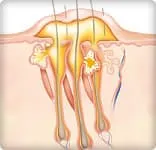A carbuncle is a red, swollen, and painful cluster of boils that are connected to each other under the skin. A boil (or furuncle) is an infection of a hair follicle that has a small collection of pus (called an abscess) under the skin. Usually single, a carbuncle is most likely to occur on a hairy area of the body such as the back or nape of the neck. But a carbuncle also can develop in other areas of the body such as the buttocks, thighs, groin, and armpits.

Most carbuncles are caused by Staphylococcus aureus bacteria, which inhabit the skin surface, throat, and nasal passages. These bacteria can cause infection by entering the skin through a hair follicle, small scrape, or puncture, although sometimes there is no obvious point of entry.
Filled with pus -- a mixture of old and white blood cells, bacteria, and dead skin cells -- carbuncles must drain before they're able to heal. Carbuncles are more likely than boils to leave scars.
An active boil or carbuncle is contagious: the infection can spread to other parts of the person's body or to other people through skin-to-skin contact or the sharing of personal items. So it's important to practice appropriate self-care measures, like keeping the area clean and covered, until the carbuncle drains and heals.
Carbuncles require medical treatment to prevent or manage complications, promote healing, and minimize scarring. Contact your doctor if you have a boil or boils that have persisted for more than a few days.
Risk Factors for Carbuncles
Older age, obesity, poor hygiene, and poor overall health are associated with carbuncles. Other risk factors for carbuncles include:
- Chronic skin conditions, which damage the skin's protective barrier
- Diabetes
- Kidney disease
- Liver disease
- Any condition or treatment that weakens the immune system
Carbuncles also can occur in otherwise healthy, fit, younger people, especially those who live together in group settings such as college dorms and share items such as bed linens, towels, or clothing. In addition, people of any age can develop carbuncles from irritations or abrasions to the skin surface caused by tight clothing, shaving, or insect bites, especially in body areas with heavy perspiration.
Symptoms of Carbuncles
The boils that collect to form carbuncles usually start as red, painful bumps. The carbuncle fills with pus and develops white or yellow tips that weep, ooze, or crust. Over a period of several days, many untreated carbuncles rupture, discharging a creamy white or pink fluid.
Superficial carbuncles -- which have multiple openings on the skin's surface -- are less likely to leave a deep scar. Deep carbuncles are more likely to cause significant scarring.
Other carbuncle symptoms include fever, fatigue, and a feeling of general sickness. Swelling may occur in nearby tissue and lymph nodes, especially lymph nodes in the neck, armpit, or groin.
Complications of Carbuncles
Sometimes, carbuncles are caused by methicillin-resistant Staphylococcus aureus (MRSA) bacteria, and require treatment with potent prescription antibiotics if the lesions are not drained properly.
In rare cases, bacteria from a carbuncle can escape into the bloodstream and cause serious complications, including sepsis and infections in other parts of the body such as the lung, bones, joints, heart, blood, and central nervous system.
Sepsis is an overwhelming infection of the body that is a medical emergency and can be fatal if left untreated. Symptoms include chills, a spiking fever, rapid heart rate, and a feeling of being extremely ill.
Home Treatment for Carbuncles
The cardinal rule is to avoid squeezing or irritating a carbuncle, which increases the risk of complications and severe scarring.
Warm compresses may promote the drainage and healing of carbuncles. Gently soak the carbuncle in warm water, or apply a clean, warm, moist washcloth for 20 minutes several times per day. Similar strategies include covering the carbuncle with a clean, dry cloth and gently applying a heating pad or hot water bottle for 20 minutes several times per day. After each use, washcloths or cloths should be washed in hot water and dried at a high temperature.
Washing the carbuncle and covering the area with a sterile bandage also may promote drainage and healing and help prevent the infection from spreading. Over-the-counter medications such as acetaminophen or ibuprofen can help relieve the pain of an inflamed carbuncle.
It's important to thoroughly wash your hands after touching a carbuncle. Launder any clothing, bedding, and towels that have touched a carbuncle and avoid sharing bedding, clothing, or other personal items.
Medical Treatments for Carbuncles
See your doctor if a boil or boils do not drain and heal after a few days of home treatment or if you suspect you have a carbuncle. Also, seek medical evaluation for a carbuncle that develops on your face, near your eyes or nose, or on your spine. Also see a doctor for a carbuncle that becomes very large or painful.
Your doctor may cut and drain the carbuncle, and ensure that all the pus has been removed by washing the area with a sterile solution. Some of the pus can be collected and sent to a lab to identify the bacteria causing the infection and check for susceptibility to antibiotics.
If the carbuncle is completely drained, antibiotics are usually unnecessary. But treatment with antibiotics may be necessary in cases such as:
- When MRSA is involved and drainage is incomplete
- There is surrounding soft-tissue infection (cellulitis)
- A person has a weakened immune system
- An infection has spread to other parts of the body
Depending on severity, most carbuncles heal within two to three weeks after medical treatment.

